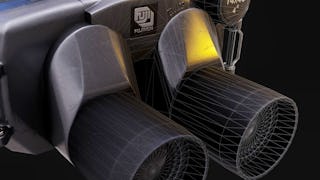This course is aimed to give you the tools and knowledge you need to start creating simple 3D art for video games made in the Unity game engine. Through the aesthetic of pixel art we will explore artistic principals like shape language, color theory, and composition as well as show you a step by step workflow for creating assets that you can use to make your own games. The course is broken into 4 main modules, props, environments, characters, and animation. Each of these courses will have a series of video lessons alternating between artistic and technical skills culminating in a peer-reviewed project based assignment. The last module will challenge you to take the knowledge learned in the previous 4 and use it to create your own pixel art asset pack.

Enjoy unlimited growth with a year of Coursera Plus for $199 (regularly $399). Save now.

Low Poly Art For Video Games
This course is part of Art for Games Specialization


Instructors: Andrew Dennis
9,860 already enrolled
Included with
(73 reviews)
Recommended experience
Skills you'll gain
Details to know

Add to your LinkedIn profile
See how employees at top companies are mastering in-demand skills

Build your subject-matter expertise
- Learn new concepts from industry experts
- Gain a foundational understanding of a subject or tool
- Develop job-relevant skills with hands-on projects
- Earn a shareable career certificate

There are 5 modules in this course
In this first week we will talk about the basics of creating a game model in the low poly style. This will likely be the quickest of the 5 weeks, so take some time to check out the optional Maya LT intro to make sure you have a grasp of all the essential skills we will be covering in the course.
What's included
20 videos4 readings5 assignments1 peer review
In this week we will move onto environments. The goal is to create a set of simple models that can be used to create scenes in maya. Depending on the number of models and their complexity this might be a more time consuming than the previous week.
What's included
13 videos4 assignments1 peer review
What's included
13 videos3 assignments1 peer review
In this week we will be taking our character from week 3 and animating a few simple animations for it. Rigging can be tricky at first, so make sure you check out the rigging and animation primer if you need to. The goal here is to quickly get a character that we can animate, then create a few simple and expressive animations for use in a 3d game.
What's included
7 videos3 assignments1 peer review
For the final week, take the project assets you have made so far and improve them based on the feedback you received. Take this week to go back and redo anything you would have like to tackle in a different way. The goal here is to finish with a series of low poly assets you could use in a simple 3d game.
What's included
1 assignment1 peer review
Earn a career certificate
Add this credential to your LinkedIn profile, resume, or CV. Share it on social media and in your performance review.
Instructors


Offered by
Explore more from Music and Art
 Status: Free Trial
Status: Free TrialMichigan State University
 Status: Free Trial
Status: Free TrialMichigan State University
 Status: Free Trial
Status: Free TrialMichigan State University
 Status: Free Trial
Status: Free Trial
Why people choose Coursera for their career




Learner reviews
73 reviews
- 5 stars
61.64%
- 4 stars
21.91%
- 3 stars
2.73%
- 2 stars
8.21%
- 1 star
5.47%
Showing 3 of 73
Reviewed on Oct 24, 2024
I wish they would update the course for this year (2024). But I was still able to make great use of the lessons.
Reviewed on Dec 11, 2019
This course assumes you are already familiar with Maya software, I had a hard time trying to grasp the software
Reviewed on Nov 14, 2020
A nice course to learn modeling and rigging with Maya! I liked the course!
Frequently asked questions
The course is designed with Photoshop and MayaLT in mind due to their place as industry standard tools. You may use other tools if you wish (blender, gimp, etc) and apply the same techniques to those programs, but keep in mind the course was designed for Photoshop and Maya
Projects and companies can vary wildly between who is responsible for what. Even if you end up working on a project where you as an artist simply create the art and are not required to handle the engine side of things; understanding how to prepare an asset for a game engine and the work involved will make you a better team member. You should always strive to have some understanding of how your work interfaces with others.
While the style taught here is simple 3d game art designed to get you up and running quickly, you will find the difficulty of the projects has a lot to do with the complexity you attempt. If it is your first time tackling these subjects I recommend keeping it simple for this course. You can always spend more time later improving and polishing your work. Perfect is the enemy of done!
More questions
Financial aid available,
¹ Some assignments in this course are AI-graded. For these assignments, your data will be used in accordance with Coursera's Privacy Notice.





